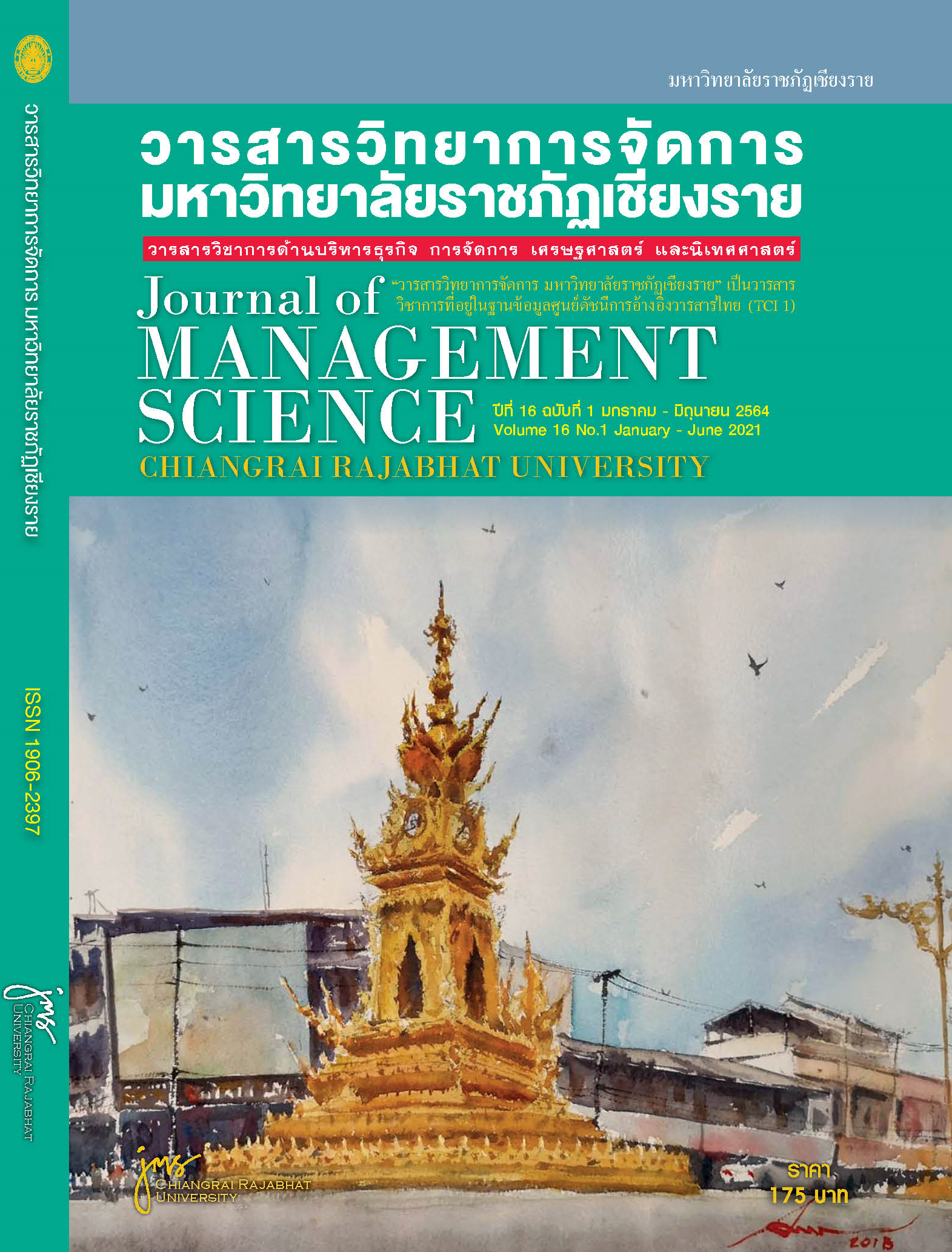R&D Spending and Share Price of Listed Companies in the Stock Exchange of Thailand
Main Article Content
Abstract
The study’s main objective aimed to examine possible relationship between research and development (R&D) spending and common share price of listed companies from the Stock Exchange of Thailand (SET). Using stratified random sampling, 210 corporate annual reports of seven industries from the SET were used as the samples. Corporate annual reports during 2016 to 2018 were used to collect R&D spending and corporate characteristics, while SETSMART was used to collect common share price of samples. Descriptive analysis, correlation matrix and panel data analysis were used to analyze the data. As the results, the study found a significantly negative relationship between R&D spending and common share price at 0.05 level, and there was significant relationship between firm size, firm age, audit type, risk, profitability, and share price at 0.05 and 0.01 levels. Using sensitivity analysis, this study found that there was a significantly negative relationship between development spending and common share price at 0.05 level, while no correlation was between research spending and share price at 0.05 level. This study demonstrated that the theory of stock investment and speculator can be used to explain a negative relationship between R&D spending and share price of listed companies in the SET as well as a negative relationship between development spending and share price.
Article Details
Views and opinions expressed in the journal do not necessarily reflect those of the editors.
References
Berk, J.B., Green, R.C. and Naik, V. (2004) Valuation and return dynamics of new ventures. Review of Financial Studies 17(1): 1-35.
Duqi, A., Mirti, R. and Torluccio, G. (2011) An analysis of the R&D effect on stock returns for European listed firms. European Journal of Scientific Research 58(4): 482-496.
Callimaci, A. and Landry, S. (2004) Market valuation of research and development spending under Canadian GAAP. Canadian Accounting Perspective 3(1): 33-53.
Cazavan-Jeny, A. and Jeanjean, T. (2006) The negative impact of R&D capitalization: a value relevance approach. European Accounting Review 15(1): 37-61.
Chamber, D., Jennings, R. and Thompson, R.B. (2002) Excess returns to R&D intensive firm. Review of Accounting Studies 7(1): 133-158.
Chan, K., Louis, C., Lakonishok, J. and Sougiannis, T. (2001) The stock market valuation of research and development expenditures. The Journal of Finance 56(6): 2431-2456.
Ekpol, S. (2007) Relationship between firm life cycle, firm size, research and development expenditure and stock returns. Master Thesis of Accounting Program. Chulalongkorn University, Bangkok, Thailand.
Franzen, L. and Radhakrishnan, S. (2009) The value relevance of R&D across profit and loss firms. Journal of Accounting and Public Policy 28(1): 16-32.
Gharbi, S., Sahut, J.M. and Teulon, F. (2014) R&D investment and high-tech forms’ stock return volatility. Technology Forecasting & Social Change 12(2): 306-312.
Han, B.H. and Manry, D. (2004) The value-relevance of R&D and advertising expenditures: evidence from Korea. The International Journal of Accounting 39(2): 155-173.
Jiang, C., John, K. and Larsen, D. (2019) R&D Investment Intensity and Jump Volatility of Stock Price. The FMA Annual Meeting at 23-26 October 2019, New Orleans, USA.
Lev, B., Sougiannis, T. and Sarath, B. (2005) R&D reporting biases and their consequences. Contemporary Accounting Research 22(4): 977-1026.
Manomansatham, W. (2015) The relationship between company characteristics and R&D disclosure: a case of listed companies in the Stock Exchange of Thailand. Master Independent Study of Accountancy Program, Thammasat University, Bangkok, Thailand.
Mozafari, S. (2017) The impact of R&D expenditure volatility on stock return of the listed companies in Tehran Stock Exchange. Specialty Journal of Accounting and Economics 3(2): 7-11.
Nord, L. (2011) R&D investment link to profitability: a pharmaceutical industry evaluation. Undergraduate Economic Review 8(1): 25-57.
Penman, S. and Zhang, H.X. (2002) Accounting conservatism, the quality of earnings and stock returns. Accounting Review 77(2): 237-264.
Saad, M. and Zantout, Z. (2008) Stock price and systematic risk effect of discontinuation of corporate R&D programs. Journal of Empirical Finance 16(4): 568-581.
Sangnapawan, P. (2007) Research and development disclosures of listed companies in Agriculture and food industry in the Stock Exchange of Thailand. Master Independent Study of Accountancy Program, Chiang Mai University, Chiang Mai, Thailand.
Siripong, W., Phramhan, N., Pimpakarn, P., Panyaying, R., Saengsri, S., Malawaichan, I. and Suttipun, M. (2019) The relationship between research and development disclosure and financial performance of listed companies in the Stock Exchange of Thailand (SET). MUT Journal of Business Administration 16(2): 173-190.
Suttipun, M. (2018) Association between board composition and intellectual capital disclosure: an evidence from Thailand. Journal of Business Administration 41(160): 74-97.
Thailand Financial Reporting Standards (TFRS). (2017) Intangible Asset. Federation of Accounting Professions under the Royal Patronage of His Majesty the King, Bangkok, Thailand.
Titi, A. (2014) The effect of R&D expenditures on stock returns, price, and volatility. Master Degree Project in Finance, University of Gothenburg, Gothenburg, Sweden.
Vanstraelen, A., Schelleman, C., Meuwissen, R. and Hofmann, I. (2012) The audit reporting debated seemingly intractable problems and solutions. European Accounting Review 21(2): 193-215.
Wu, C. and Wei, K.C.J. (1998) Cooperative R&D and the value of the firm. Review of Industrial Organization 13(3): 425-446.


